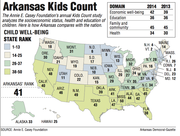Arkansas dropped one spot nationally -- from 40 to 41 -- in this year's Annie E. Casey Foundation Kids Count study on children's well-being, though the state improved from last year's statistics in more categories than it declined in.
More Arkansas children lived in poverty and in high-poverty areas in 2012 than in 2011, which fits the national trend, according to the 25th annual study.
The Baltimore-based foundation releases statistics each year in 16 categories -- that comprise four indicators of four categories each -- based on the latest federal governmental data available for each category. In 2014, most of the data were from 2012. Last year, most of the data were from 2011.
State agencies use the study, among others, to gauge the success of strategies targeting specific areas, said Kate Luck, a spokesman for the Arkansas Department of Human Services.
Arkansas improved in seven of the 16 categories, did worse in six and remained unchanged in three. Nationwide, children's conditions improved in 11 categories, got worse in three and stayed the same in two.
"Even as we have gotten better on a lot of our indicators, so have other states," said Arkansas Advocates for Children and Families Director Rich Huddleston. "So it's not just enough to improve every year because other states are also improving."
The seven areas in which Arkansas improved were: children whose parents lack secure employment, children living in households with a high housing-cost burden, fourth-graders not proficient in reading, eighth-graders not proficient in math, low birth-weight babies, children in single-parent families and teen birth rate per 1,000 births.
Only one of those categories varies with the nationwide trend toward improvement -- the number of children in single-parent families -- which was one category where the country as a whole was worse off.
In addition to children living in poverty and high-poverty areas, the state was worse off in high school students not graduating on time, children in families where the head of household lacks a high school diploma, teens not in school and not working, and children without health insurance.
From 2011 to 2012, 2,000 more children went without health insurance, but the rate still hovered around 6 percent -- compared with 7 percent nationally. In 2012, 42,000 children were uninsured in Arkansas.
Huddleston and Luck said they're optimistic that the rate of uninsured children will go down in next year's figures, given the number of new enrollees in the ARKids First program.
The program provides health insurance for children who would otherwise not receive it. Huddleston said that last fall, 25,000 children enrolled in the program, likely because their parents enrolled in Arkansas' new private insurance exchange and discovered in the process that their children were eligible for ARKids First.
Although slightly increased from several years ago, the number of children not enrolled in preschool was unchanged from 2011 to 2012, with more than half not attending.
Huddleston said that was the result of flat funding for the state's preschool program, Arkansas Better Chance, which has received $111 million each year for the past eight years.
Huddleston said that flat salaries don't attract good teachers and that a lack of funding increases could push some preschools to lower the quality of education or close their doors entirely.
"We need to make kids a top priority in the state budget, and we don't always do that," Huddleston said.
A section on 07/22/2014

